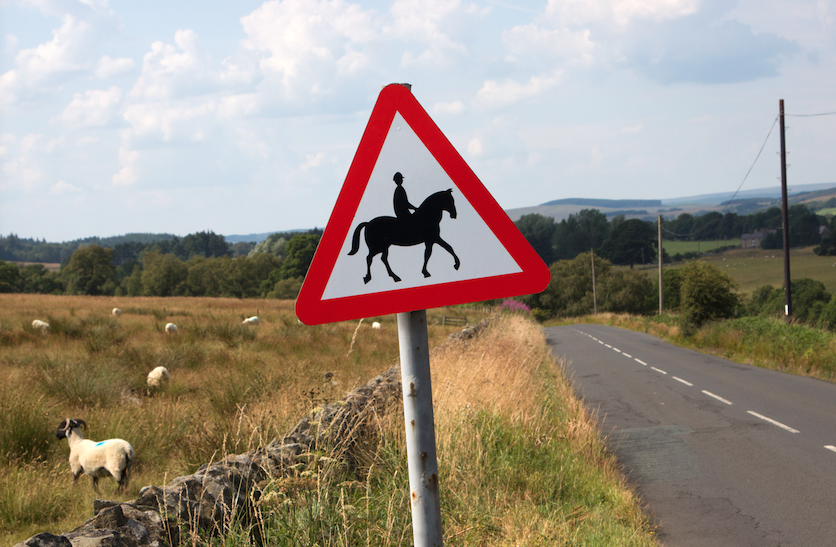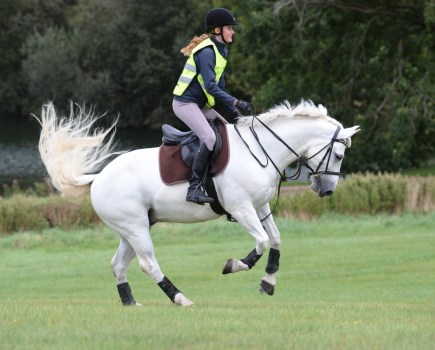The colour of the clothes and accessories you choose to wear when hacking a horse on the road can mean the difference between being seen by a driver or not — and it isn’t necessarily the usual yellow, orange or pink high vis that work best.
Have you ever wondered wondered why traffic lights, brake lights and road warning signs are all red?
The retina of our eyes has two types of light-sensitive cells called rods and cones, found in a layer at the back the eye which processes images. These cones are receivers for tiny visible light waves.
The sun is a natural source for visible light waves and our eyes see the reflection of this sunlight off the objects all around us.
The colour of an object that we see is the colour of light reflected, while all other colours are absorbed.
Car headlights are another source of visible light waves.
Why red is so effective
Red has the longest wavelength of all colours in the visible spectrum. Its long wavelength results in red colours being scattered the least.
Due to the receptors for red colours in the human eye being clustered in the area near the centre, where the sharpest images are formed, it is easily visible over long distances — even in conditions such as rain and fog.
This is why it is so effective when used to indicate danger.
Each colour has affects people differently — and sometimes even subconsciously. In our minds, red is associated with stopping.
In the workplace, for example, when we see a red warning sign we instinctively know to stop our task in hand.
On a UK motorway, a red X tells us that a lane is closed. Red is used to warn of the highest levels of danger, and it stimulates the strongest emotions of any colour.
Studies show that being exposed to or wearing the colour red can cause some of the following physical effects:
- Elevated blood pressure.
- Enhanced metabolism.
- Increased heart rate.
- Increased respiration rate.
All of these physiological changes naturally cause your energy levels to spike.
As riders, we want to wear a colour that has the greatest visibility in order to help us be seen and stay safe when out hacking.
Seeing a horse and rider wearing red prompts an immediate positive response from drivers and other road users to slow down.
Red signals danger in nature
Some biologists say that nature uses red as a warning colour because it stands out most vividly against a green background.
Alternative theories as to why red is so effective are that we associate it with danger because it is the colour of fire and blood.
That said, warning signs in China have black borders on a yellow background, so red isn’t always the first choice for signalling danger.
Yellow and black, however, is also a strong colour combination. It’s the colour of wasps and hornets, plus poisonous frogs and other species to be wary of.
Studies suggest that red is the most intense colour and provokes the strongest reaction, not only among humans but also other primates. The next strongest colours are pink, orange, yellow and white.
Certain members of the animal kingdom go out of their way to inform others that they pose a threat, and some accomplish this through colour.
This characteristic is called aposematism and it concerns the contrast of the bright colour with another colour, usually black.
Take, for example, a skunk. Its black body with a broad white stripe reminds others not to get too close.
A wasp’s colours signal a potential sting, and the brighter the ladybird, the higher its toxicity. Studies show that white, yellow, red and black are the most effective warning colours brandished by animals.
In the same manner that signs caution motorists, colourful animal markings are nature’s way of saying ‘watch out’.
This is the very message that riders want to convey to motorists when they see us on the road.
Traffic light colour codes
Red for STOP
Red is a very powerful colour. It symbolises love and passion, but it is also traditional for warning and danger: red alert, red card, red flag, seeing red.
The association of the colour red with danger has been exemplified in many ways from ancient to modern times.
Yellow for CAUTION
Yellow is very visible and has been a favourite for riders for years. It was first used for safety clothing in 1964.
High-vis pink arrived in the equine market 35 years later.
One theory is that yellow is eye-grabbing because of its associations with the natural world. Bees and wasps are yellow and black to signify how dangerous they are and to warn predators away.
Yellow makes our subconscious minds take notice. Its visibility and association with danger make it perfect for the tier of danger below red.
You can tell from a yellow sign that there is a potential hazard ahead, but you will notice the red signs first for immediate dangers.
Green for GO
Green is seen as a safe colour. It symbolises life and therefore safety, and it is calming.
Green is for fire exits, first aid kits and the colour worn by paramedics, for example. That is why green is for go.
Good manners
Using good quality high-vis clothing on both yourself and your horse helps drivers see you, allowing them sufficient time to slow down and give you a wide berth.
However, I believe riders can do more by striving to be polite on the roads.
Wearing high-vis is very important, but so is thanking drivers whenever possible.
If a driver has made a conscious effort to respect you and your horse by passing slow and wide, then it is important to thank them, by a wave if safe to do so, or a nod of the head, and best of all a smile.
How many drivers look at you for a thank you when they have shown consideration? From my experience through years of hacking, it’s a lot.
Educating drivers
This small but important gesture — a smile — means you have just educated the driver on how to pass a horse and rider safely on the road.
Having experienced a positive encounter, the hope is that a connection will be made that the action taken was correct.
Next time that driver meets a rider, nine times out of 10 their behaviour will be repeated. Conversely, if a rider does not show appreciation, any subsequent riders may not receive the same consideration.
Not all drivers know what to do when passing a horse. We know what horses are thinking, but people with no experience of horses can find a horse and rider on the road daunting.
It’s our job to reassure them and to give them the confidence to do the right thing.
We all have a responsibility for each other’s safety — we’re on the same team. The more riders work together, the more we can achieve our goal of being able to stay safe on the road.
Smiling, transmitted either consciously or subconsciously, is viewed across cultures as a sign of friendliness.
Horse riders sometimes gain a bad reputation, so let’s prove those people wrong. It takes 43 muscles to frown and only 17 muscles to smile, so not only does smiling send a positive message, it also means fewer wrinkles. Win-win!
Main image © Shutterstock








